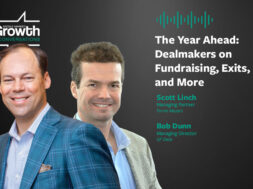What’s Next for PE Firms: An SEC Update
Emilie Abate of Iron Road Partners shares her insights into how regulation of the private equity space is shaping up

Earlier this summer, the Fifth Circuit Court vacated the Securities and Exchange Commission’s Private Fund Adviser Rules (PFAR), a relief for private equity funds struggling with the new level of oversight. Emilie Abate, a former SEC compliance examiner and branch chief, now director of Iron Road Partners, sat down with Middle Market Growth to share what this means for firms, emerging areas of interest for the SEC and how potential battlegrounds like NAV loans are shaping up.
Middle Market Growth: What do you think the implications are for PE firms with PFAR lapsing? What do you think are the SEC’s next steps?
Emilie Abate: PFAR was aggressive and felt very restrictive, and I think firms were having a hard time figuring out where they were going to find the budget to be able to comply with all of the new reporting requirements. The regime we’re under now is disclosure-based, and I don’t know that that will ever change given the Advisers Act. The decision in the Fifth Circuit wasn’t great for the SEC, but at the same time they still have plenty of ammo to regulate private equity, as we’re seeing with exams and recent enforcement actions.
Their examiners are still very aggressive and they’re not necessarily poking at the things that the SEC was hoping to push through in PFAR. They’re looking at very current issues impacting managers, anything ranging from NAV loans to AI to cybersecurity. Exam staff have expertise across many fronts and they have the ability to gather information from a diversified set of firms. From a rulemaking perspective, it seems like the SEC is still trying to push forward. I just don’t know how far they’ll get in the short period of time leading up to the election.
MMG: From the other side, how are PE firms reacting to this ruling?
EA: I think PFAR made investors feel like they had a seat at the table and a voice. So, although the rule itself has gone away, a number of our clients are developing some sort of quarterly reporting similar to what the rule would have required because investors are demanding it. PE firms are having to dedicate resources and be more transparent because investors are now requesting to see more detail.
It’s interesting how far PFAR has reached, because traditionally, aside from the custody rule with financial statement audits, finance teams have been more sheltered, with compliance teams serving as the ones really dealing with the Advisers Act requirements and the nuances and complexities of how to run a compliance program. I think PFAR opened a lot of eyes within shops. Finance departments are now spending more time scrutinizing data and looking at the categorization of fees and expenses charged to funds and are just generally more aware of SEC rule-making and activity.
FAR made investors feel like they had a seat at the table and a voice. So, although the rule itself has gone away, a number of our clients are developing some sort of quarterly reporting similar to what the rule would have required because investors are demanding it.
MMG: Are NAV loans shaping up to be another battleground between PE and the SEC? How do you see that developing?
EA: As the industry has evolved and NAV loans have become more common, examiners have kept pace, and they’re asking a lot of interesting questions that compliance departments may not yet have contemplated. I think examiners will certainly have questions around the reason for utilizing an NAV loan and the associated mechanics, but another question will be: Are LPs aware that you took out a NAV loan? “Well, our fund documents are silent and don’t require approval, so we went ahead with it, and investors have not been informed,” is something that would raise eyebrows with examiners.
We’ve also seen a lot of questions around calculation of management fee base. When it comes to NAV loans, compliance should be prepared to answer questions such as: Is the NAV loan increasing your level of invested capital, and therefore increasing your management fee base? If it is, do your fund docs explicitly allow for it? Additionally, has this practice and associated conflict of interest been properly disclosed? Identifying conflicts is a big part of what examiners do, and as we continue to see questions contemplating the composition of the management fee base, it feels natural that NAV loans will be the next topic of conversation amongst examiners.
Also, are you using an affiliate to assist with the transaction? Is that affiliate earning a fee or benefitting in any way? Are you, as the adviser or through any of its affiliates, being compensated? That is what examiners will try to determine when it comes to NAV loans, and they’re going to look to disclosures to determine what information investors were provided with. Examiners will always look to see if disclosures align with actual practices, and if the firm has disclosed all relevant conflicts of interest.
MMG: Can you give us any insight into what the SEC’s recent document request list might mean for PE firms?
EA: You can see examiners are really focused on the calculation of the management fee base right now. Following the Insight case, we’ve seen examiners focused on the valuation of impaired assets. Do you have investments that have been permanently impaired? Do you have any investments that have no chance of recovery that should have been written off and taken out of your management fee base? Of course, it all depends on how your fund documents read, but you may have an investment that hovers at zero or right above it for several consecutive quarters: Do you think there is still value? Can you recover anything, or should it be taken out of your management fee base? Additionally, do you have a process to monitor and document the decision making around impairment?
We’re also seeing a lot of portfolio company restructurings in this current economic environment. How does that impact your management fee base? This all comes back to examiners trying to figure out if investors have been charged the right amount of fees.
Another theme you see throughout the request list is the use of affiliated service providers—again, fees and expenses are a big focus area for examiners. In private equity, it’s common to be vertically integrated: It’s operationally efficient, it’s often less expensive. Still, however, examiners consider the use of affiliated service providers to be high risk, so they’ll really dig in. So, do you have policies and procedures to manage the risk? Do you have adequate resources and controls in place to monitor what the fund is paying and who they’re paying? How much are you charging? Do you conduct periodic benchmarking? Do you have a compliance program built around the process to be able to conduct period testing? All of these are common examiner questions that compliance departments should be prepared to answer.
The other area that I noticed in the request list that we’ve seen quite a bit of, too, is investment diligence. We’ve been in this period where there’s been an incredible amount of dry powder, and we’ve seen some really significant fundraises with firms deploying capital in so many different industries at an unprecedented pace, especially in private equity. While growth may have slowed in recent months, examiners are going to be conducting a historic look-back of the last few years, and they will be focused on questions like: What does your investment diligence process look like? Are you scrutinizing the financial statements? Are you engaging third-party specialists to assist on topics such as ESG? On the flip side of that, are you coming in and doing your own diligence, or is everyone relying on diligence conducted by the lead investor? From a review and approval perspective, does every single investment go through the investment committee? And what does the actual diligence documentation look like?
And if you do find red flags during the investment diligence process, the worst thing you can do is have them sitting in the file without documentation to explain mitigating factors. Examiners are going to come in and request your entire investment diligence folder, and you want to make sure that any significant red flags are addressed.
If you do find red flags during the investment diligence process, the worst thing you can do is have them sitting in the file without documentation to explain mitigating factors.
Also, cybersecurity has become a standard question, specifically whether you have experienced any data breaches or unauthorized system access. Even if it was a small breach, do you have documentation to show that investor information was not viewed or exfiltrated? Have you conducted an analysis to determine that any sensitive personally identifiable information was not breached? And more broadly, can your CCO speak to the cybersecurity controls, and convey that their oversight of the IT function is adequate? Compliance will be expected to be able to answer these questions during the course of an exam.
MMG: What does the SEC’s most recent regulatory agenda indicate is coming down the pike?
EA: The industry is certainly experiencing fatigue when it comes to rulemaking, but there are still some significant pending proposed rules that could be impactful. Rules around custody and outsourced service providers are where our clients are really on the edge of their seats: Where will this land? Do we have the resources to be able to deal with this? Predictive analytics feels a little bit further down the list, but would be impactful nonetheless.
We’re obviously in an election year, and fiscal year-end for the SEC is September 30th, so we’ll see a big push to close out open exams. And I’m sure you’ve seen, and will continue to see, quite a few enforcement cases come out as well. How much can the SEC get done before the election? I think they’ll continue to try and get as much done as they possibly can under this current regime.
MMG: How do you see the presidential election impacting the SEC, if at all?
EA: In our view it’s a little bit less about presidential election, though obviously it will impact things. It feels a bit more about where we are within the “seasons” of the regulatory cycle. Where we’re sitting now, there was a switch to a pro-regulatory administration, and as a result you’ve see an uptick in regulations and a more aggressive SEC. You have to beef up your compliance department, you see more painful exams and a lot more enforcement cases, and frustration starts to build. We’re currently at this point in the cycle, where we’re seeing a lot of enforcement cases that seem to target “foot faults” or common business practices, and some really long, drawn-out exams. It feels like regulatory overreach sometimes. But that is typically the peak, and then a regime change occurs. You’ll see the SEC pivot, the messaging starts to sound different, enforcement cases start to slow, your exams may not take as long or do as deep of a dive. Obviously, the examiners are very talented, and they really love what they do, so there will always be the risk of a tough exam, so from that perspective, compliance departments always need to be on their toes. But I think we’re at that that inflection point in the regulatory cycle, and depending on where the election lands, we’ll either move into the next phase of the cycle, or we’ll sit in the current holding pattern until we see a regime change.
Hilary Collins is ACG’s Associate Editor.
Middle Market Growth is produced by the Association for Corporate Growth. To learn more about the organization and how to become a member, visit www.acg.org.


